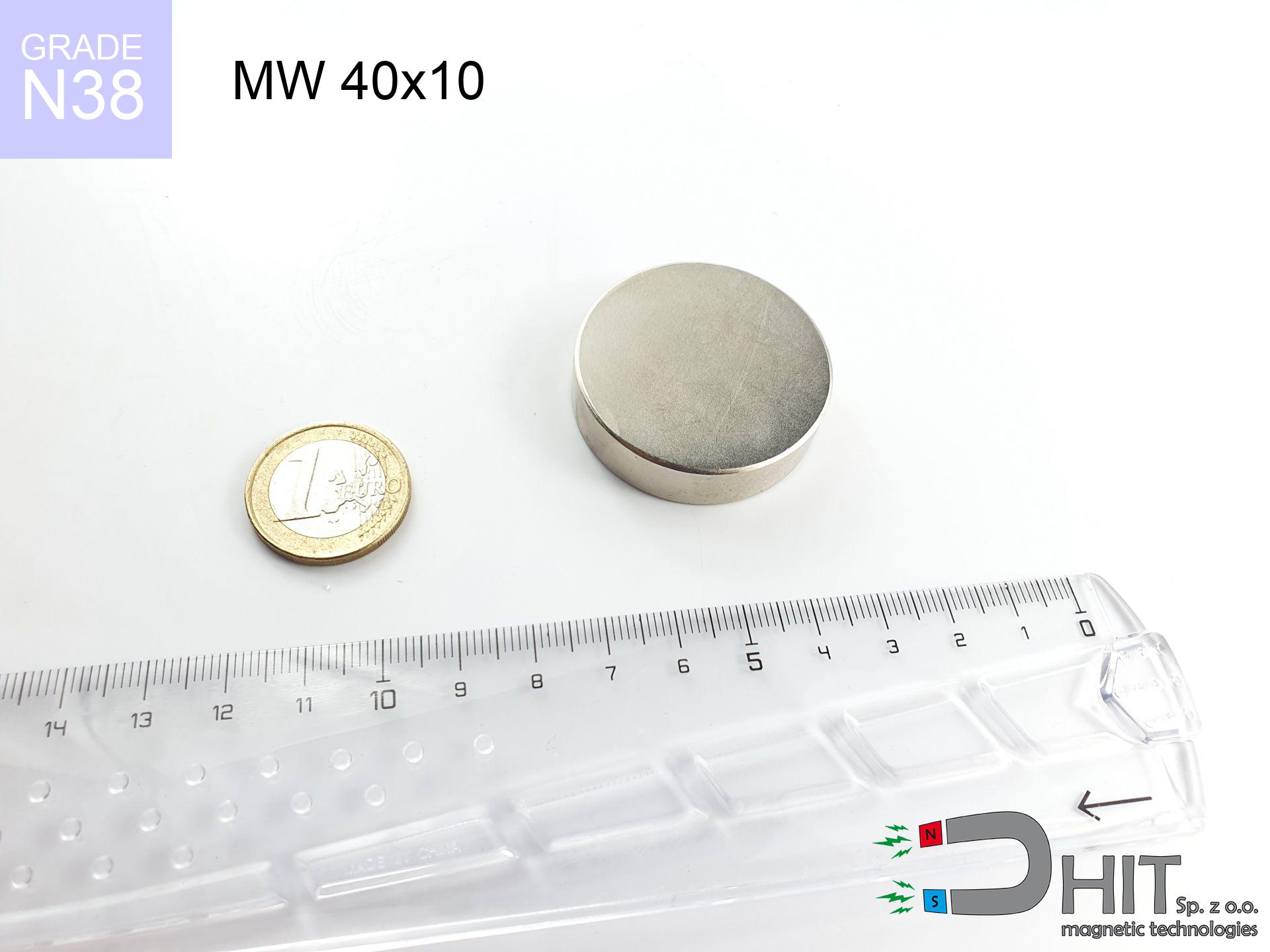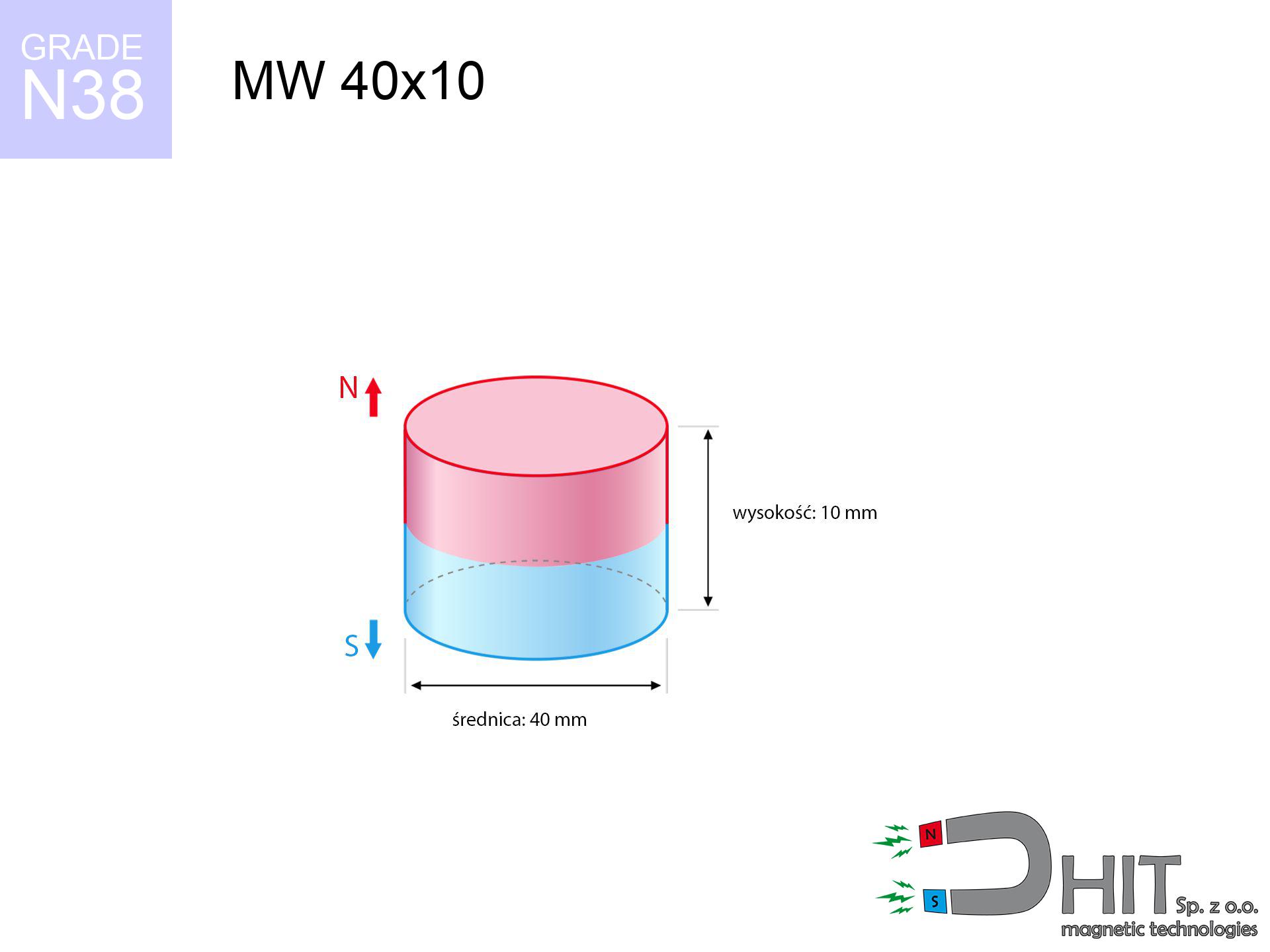MW 40x10 / N38 - cylindrical magnet
cylindrical magnet
Catalog no 010066
GTIN: 5906301810650
Diameter Ø [±0,1 mm]
40 mm
Height [±0,1 mm]
10 mm
Weight
94.25 g
Magnetization Direction
↑ axial
Load capacity
22.12 kg / 216.92 N
Magnetic Induction
277.22 mT
Coating
[NiCuNi] nickel
36.57 ZŁ with VAT / pcs + price for transport
29.73 ZŁ net + 23% VAT / pcs
bulk discounts:
Need more?Need advice?
Give us a call
+48 22 499 98 98
otherwise drop us a message by means of
contact form
through our site.
Force along with appearance of a neodymium magnet can be analyzed on our
force calculator.
Order by 14:00 and we’ll ship today!
MW 40x10 / N38 - cylindrical magnet
Magnetic properties of material N38
Physical properties of NdFeB
Shopping tips
Moreover, although neodymium is a component of the strongest magnets, they are prone to corrosion in humid environments. For this reason, they are coated with a coating of gold-nickel to increase their durability. Interestingly that NdFeB neodymium magnets are about 13% lighter than SmCo magnets and, despite their power, are brittle, which requires special caution during their handling. Therefore, any mechanical processing should be done before they are magnetized.
In terms of safety, there are many recommendations regarding the use of these magnets. It is advisable to avoid their use in acidic, basic, organic environments or where solvents are present, and also in water or oil. Furthermore, they can damage data on magnetic cards and hard drives, although data deletion using a neodymium magnet is not always certain.
In terms of properties in different environments, neodymium magnets are susceptible to corrosion, especially in humid conditions. Therefore, they are often coated with coatings, such as silver, to shield them from external factors and prolong their durability. High temperatures exceeding 130°C can result in a deterioration of their magnetic properties, although there are particular types of neodymium magnets that can withstand temperatures up to 230°C.
As for potential dangers, it is important to avoid using neodymium magnets in acidic environments, basic environments, organic or solvent environments, unless they are adequately insulated. Additionally, their use is not recommended in water, oil, or in an environment containing hydrogen, as they may forfeit their magnetic properties.
Advantages as well as disadvantages of neodymium magnets NdFeB.
Besides their stability, neodymium magnets are valued for these benefits:
- They do not lose their strength approximately 10 years – the decrease of power is only ~1% (based on measurements),
- They protect against demagnetization induced by surrounding magnetic fields effectively,
- By applying a reflective layer of nickel, the element gains a sleek look,
- They exhibit elevated levels of magnetic induction near the outer area of the magnet,
- Thanks to their high temperature resistance, they can operate (depending on the shape) even at temperatures up to 230°C or more,
- Thanks to the flexibility in shaping and the capability to adapt to specific requirements, neodymium magnets can be created in diverse shapes and sizes, which expands their usage potential,
- Significant impact in cutting-edge sectors – they are used in computer drives, electromechanical systems, diagnostic apparatus along with sophisticated instruments,
- Compactness – despite their small size, they provide high effectiveness, making them ideal for precision applications
Disadvantages of rare earth magnets:
- They may fracture when subjected to a strong impact. If the magnets are exposed to physical collisions, they should be placed in a metal holder. The steel housing, in the form of a holder, protects the magnet from cracks while also enhances its overall durability,
- They lose power at high temperatures. Most neodymium magnets experience permanent loss in strength when heated above 80°C (depending on the shape and height). However, we offer special variants with high temperature resistance that can operate up to 230°C or higher,
- Magnets exposed to humidity can corrode. Therefore, for outdoor applications, we advise waterproof types made of non-metallic composites,
- The use of a protective casing or external holder is recommended, since machining multi-axis shapes in neodymium magnets is risky,
- Potential hazard due to small fragments may arise, especially if swallowed, which is important in the family environments. Furthermore, miniature parts from these assemblies might interfere with diagnostics after being swallowed,
- Higher purchase price is one of the drawbacks compared to ceramic magnets, especially in budget-sensitive applications
Optimal lifting capacity of a neodymium magnet – what affects it?
The given pulling force of the magnet represents the maximum force, measured in ideal conditions, specifically:
- using a steel plate with low carbon content, acting as a magnetic circuit closure
- having a thickness of no less than 10 millimeters
- with a polished side
- in conditions of no clearance
- in a perpendicular direction of force
- at room temperature
Practical lifting capacity: influencing factors
The lifting capacity of a magnet is determined by in practice the following factors, from primary to secondary:
- Air gap between the magnet and the plate, as even a very small distance (e.g. 0.5 mm) can cause a drop in lifting force of up to 50%.
- Direction of applied force, because the maximum lifting capacity is achieved under perpendicular application. The force required to slide the magnet along the plate is usually several times lower.
- Thickness of the plate, as a plate that is too thin causes part of the magnetic flux not to be used and to remain wasted in the air.
- Material of the plate, because higher carbon content lowers holding force, while higher iron content increases it. The best choice is steel with high magnetic permeability and high saturation induction.
- Surface of the plate, because the more smooth and polished it is, the better the contact and consequently the greater the magnetic saturation.
- Operating temperature, since all permanent magnets have a negative temperature coefficient. This means that at high temperatures they are weaker, while at sub-zero temperatures they become slightly stronger.
* Lifting capacity was measured with the use of a polished steel plate of suitable thickness (min. 20 mm), under perpendicular pulling force, in contrast under attempts to slide the magnet the lifting capacity is smaller. Moreover, even a slight gap {between} the magnet and the plate decreases the lifting capacity.
Caution with Neodymium Magnets
Keep neodymium magnets away from GPS and smartphones.
Magnetic fields can interfere with compasses and magnetometers used in aviation and maritime navigation, as well as internal compasses of smartphones and GPS devices. There are neodymium magnets in every smartphone, for example, in the microphone and speakers.
Magnets made of neodymium are delicate as well as can easily break as well as get damaged.
Neodymium magnets are characterized by significant fragility. Neodymium magnetic are made of metal and coated with a shiny nickel, but they are not as durable as steel. At the moment of connection between the magnets, small metal fragments can be dispersed in different directions.
It is crucial not to allow the magnets to pinch together uncontrollably or place your fingers in their path as they attract to each other.
Magnets may crack or alternatively crumble with uncontrolled joining to each other. You can't move them to each other. At a distance less than 10 cm you should hold them very strongly.
The magnet is coated with nickel - be careful if you have an allergy.
Studies show a small percentage of people have allergies to certain metals, including nickel. An allergic reaction often manifests as skin redness and rash. If you have a nickel allergy, try wearing gloves or avoid direct contact with nickel-plated neodymium magnets.
Neodymium magnets can become demagnetized at high temperatures.
Although magnets have demonstrated their effectiveness up to 80°C or 175°F, the temperature can vary depending on the type, shape, and intended use of the specific magnet.
Magnets should not be treated as toys. Therefore, it is not recommended for youngest children to have access to them.
Not all neodymium magnets are toys, so do not let children play with them. In the case of small magnets, they can be swallowed and cause choking. In such cases, the only solution is to undergo surgery to remove the magnets, and otherwise, it can even lead to death.
Neodymium magnets are the strongest magnets ever invented. Their strength can shock you.
Make sure to review all the information we have provided. This will help you avoid harm to your body and damage to the magnets.
Under no circumstances should neodymium magnets be placed near a computer HDD, TV, and wallet.
Neodymium magnets produce intense magnetic fields that can destroy magnetic media such as floppy disks, video tapes, HDDs, credit cards, magnetic ID cards, cassette tapes, or other devices. They can also destroy videos, televisions, CRT computer monitors. Remember not to place neodymium magnets close to these electronic devices.
Dust and powder from neodymium magnets are flammable.
Avoid drilling or mechanical processing of neodymium magnets. Once crushed into fine powder or dust, this material becomes highly flammable.
Neodymium magnets should not be near people with pacemakers.
Neodymium magnets generate very strong magnetic fields that can interfere with the operation of a pacemaker. This happens because such devices have a function to deactivate them in a magnetic field.
Be careful!
In order for you to know how strong neodymium magnets are and why they are so dangerous, read the article - Dangerous very powerful neodymium magnets.




![UMP 94x40 [3xM10] GW F550 Silver Black Lina / N52 - search holder UMP 94x40 [3xM10] GW F550 Silver Black Lina / N52 - search holder](https://cdn3.dhit.pl/graphics/products/ump-94x40-3xm10-gw-f550-lina-gub.jpg)




